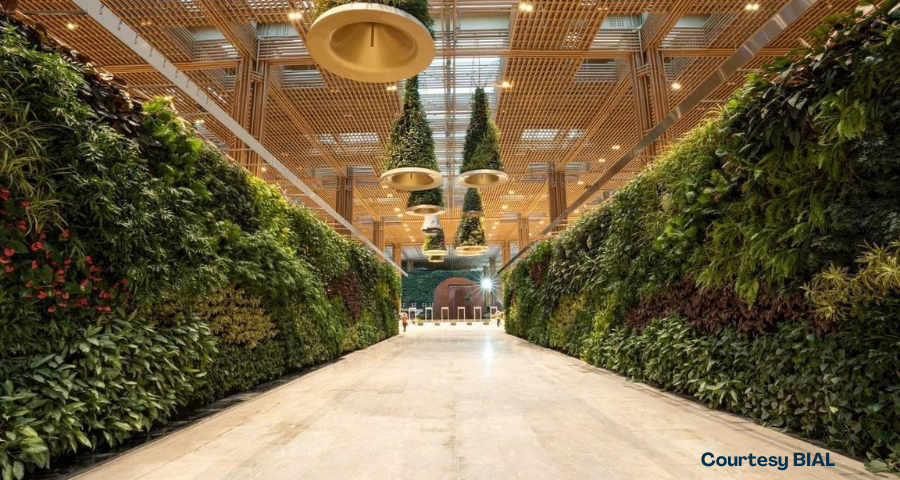We found 0 results.
View results

As India’s cities continue to evolve into sprawling hubs of progress and innovation, a transformative force is quietly reshaping the architectural narrative—biophilic design. Rooted in the fundamental connection between humans and the natural world, biophilic design transcends mere aesthetics, offering a holistic framework that reintegrates greenery, natural elements, and sustainable practices into the very fabric of urban living. In a nation where rapid urbanization coexists with a deep cultural appreciation for nature, biophilic design is emerging not just as an architectural choice but as a profound force breathing life and vitality into the spaces we call home. Let’s embark on a journey to explore the evolving urban landscapes of India and the transformative impact of biophilic design.
- The Urban Oasis:
Picture a city where every building is an oasis, seamlessly blending with nature to create a harmonious and sustainable living experience. In the urban landscapes of the future, rooftops will no longer be barren expanses of concrete. Green roofs and vertical gardens will transform these spaces into vibrant ecosystems, enhancing the aesthetic appeal of buildings while contributing to improved air quality and energy efficiency. In the modern metropolises of India, most of the major builders, such as HM Constructions, are now paying special attention to these aspects and integrating vertical gardens and green roofs!
- Integration with Indian Culture:
Biophilic design resonates deeply with India’s cultural ethos, where nature is revered and celebrated. It is not merely a contemporary trend but a revival of age-old principles that recognise the intrinsic bond between human beings and the natural world. Traditional architectural elements like courtyards, open spaces, and natural ventilation find new life in the context of biophilic design, fostering a connection with nature that goes beyond superficial aesthetics.
- Sustainable Architecture:
Biophilic design aligns seamlessly with India’s pursuit of sustainable living. The fusion of eco-friendly materials, energy-efficient systems, and natural ventilation creates buildings that are benchmarks of sustainable architecture. The movement is not confined to luxury residences; it permeates the broader urban landscape, ensuring that modern development aligns with principles of environmental responsibility.
- Nature-Inspired Aesthetics:
Architectural aesthetics inspired by nature’s patterns, textures, and colours become a defining feature of biophilic design. From biomimicry in building structures to leaf-inspired facades, the visual language reflects the organic shapes found in the natural world. This aesthetic approach adds a layer of beauty to the urban landscape while contributing to a visual language that resonates with the human psyche.
- Improved Well-being:
Biophilic design goes beyond aesthetics; it has a profound impact on human well-being. Incorporating natural elements into the urban environment has been proven to reduce stress, enhance mood, and improve overall mental health. Public spaces adorned with greenery, water features, and sunlight become therapeutic retreats, offering residents a respite from the fast-paced urban lifestyle.
- Biodiversity in Urban Spaces:
Biophilic design actively promotes biodiversity in urban areas. Introducing native plant species, creating green corridors, and establishing urban forests contribute to the revival of local ecosystems. This not only enhances the natural balance but also provides urban dwellers with opportunities to reconnect with native flora and fauna.
- Urban Resilience:
In the face of climate change and environmental challenges, biophilic design positions cities for greater resilience. Green infrastructure, permeable surfaces, and adaptive design principles contribute to urban resilience, ensuring that cities can withstand and recover from the impact of climate-related events.
- Government Initiatives and Policies:
Government initiatives and policies in India are aligning with the shift towards biophilic design. Urban planning authorities increasingly recognize the importance of green spaces, sustainable architecture, and biodiversity conservation in city development plans. This commitment extends beyond aesthetics, reflecting a broader responsibility to build cities that are not just economically vibrant but also ecologically responsible.
As India forges ahead in its urbanization journey, the integration of biophilic design emerges as a beacon of hope for a greener and more sustainable tomorrow. The urban landscapes of the future will not only be characterized by architectural marvels but by a profound harmony with nature. Biophilic design, with its emphasis on sustainability, well-being, and cultural integration, is not just a trend; it is a fundamental shift in the way we conceive and build our cities—a step towards a more balanced, resilient, and harmonious urban existence. In the marriage of modernity and nature, we find the promise of an urban future where each building, each street, becomes a breath of fresh air, a testament to our enduring connection with the natural world.
Embrace the green revolution! Join us in shaping urban havens with biophilic design. Experience the future- where architecture harmonizes with nature. Discover more now!
Contact us at 9180 42 555555